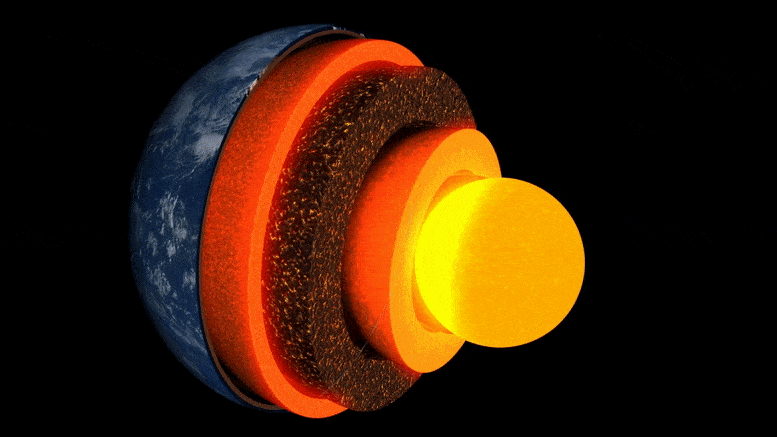地球の層のアニメーション。
ケンブリッジ大学が主導する新しい研究は、地表から約3000 kmのところにある、地球のコアとの境界層にある異常な岩のポケットの詳細な「画像」を最初に取得したものです。
ハワイ諸島のほぼ真下にある不思議な岩の領域は、非常に低速のいくつかの領域の1つです。これは、地震波が通過するときにゆっくりと這うために呼ばれます。
2022年5月19日に雑誌に掲載された研究 ネイチャーコミュニケーションズは、これらのエンクレーブの1つの複雑な内部非対称性を詳細に明らかにした最初の製品であり、地球の深い内部景観とその中で動作するプロセスに光を当てています。
「地球のすべての深遠な内部の特徴の中で、これは最も素晴らしくて複雑です。」 – 私のような
「地球のすべての深い内部の特徴の中で、これは最も魅力的で複雑です。私たちは今、その内部構造を示す最初の確かな証拠を取得しました。これは深部地震学の真のランドマークです」と博士課程の学生である筆頭著者のZhiLiは述べています。ケンブリッジの地球科学部で。
地球の内部はタマネギのように形成されています。中央にはマントルと呼ばれる厚い層に囲まれた鉄ニッケルのコアがあり、その上には薄い外側の地殻、つまり私たちが住んでいる地殻があります。 マントルは固い岩ですが、非常にゆっくりと流れるほどの高温です。 内部の対流は地表に熱を供給し、構造プレートの動きを引き起こし、火山の噴火を助長します。
科学者は地震からの地震波を使用して、地球の表面の下にあるものを「見る」ことができます。これらの波のエコーと影は、レーダーのような深部内部の画像を明らかにします。 しかし最近まで、私たちの惑星の内部熱流を研究するための主要な関心領域であるコア-マントル境界の構造の「画像」は、粒子が粗く、解釈が困難でした。

この研究で使用されたSdiff光線のイベントと軌道。 a)ハワイの超低速領域の中心を通る断面。1DPREMEarthモデルの96°、100°、110°、120°でのSdiff波の光線軌道を示しています。 上から下への破線は、410 km、660 km、および2,791 km(コアとマントルの境界から100 km上)の不連続性を示しています。 b)深さ2791kmでのバックグラウンドトモグラフィーモデルSEMUCB_WM1のイベントとSdiff光線の軌跡。 20100,320(黄色)、20111214(緑)、20120417(赤)、20180910(紫)、20180518(茶色)、20181030(ピンク)、20161122(灰色)、ステーション(三角形)など、さまざまな色で描かれたイベント用のビーチボール、および光線。 この研究で使用されたメソスフェアの穴の深さ2791kmでのスディフ波の軌道。 短期間の分析で使用されたイベントは黄色で強調表示されます。 提案されたULVZの場所は黒丸で示されています。 破線は、Aで描かれた断面を示しています。クレジット:Nature Communications、DOI:10.1038 / s41467-022-30502-5
研究者たちは、最先端の数値モデリング手法を使用して、コアとマントルの境界にあるキロメートルスケールの構造を検出しました。 共著者のKuangdaiLeng博士によると、[{” attribute=””>University of Oxford, “We are really pushing the limits of modern high-performance computing for elastodynamic simulations, taking advantage of wave symmetries unnoticed or unused before.” Leng, who is currently based at the Science and Technology Facilities Council, says that this means they can improve the resolution of the images by an order of magnitude compared to previous work.
The researchers observed a 40% reduction in the speed of seismic waves traveling at the base of the ultra-low velocity zone beneath Hawaii. This supports existing proposals that the zone contains much more iron than the surrounding rocks – meaning it is denser and more sluggish. “It’s possible that this iron-rich material is a remnant of ancient rocks from Earth’s early history or even that iron might be leaking from the core by an unknown means,” said project lead Dr Sanne Cottaar from Cambridge Earth Sciences.

Conceptual cartoons of the Hawaiian ultra-low velocity zone (ULVZ) structure. A) ULVZ on the core–mantle boundary at the base of the Hawaiian plume (height is not to scale). B) a zoom in of the modeled ULVZ structure, showing interpreted trapped postcursor waves (note that the waves analyzed have horizontal displacement). Credit: Nature Communications, DOI: 10.1038/s41467-022-30502-5
The research could also help scientists understand what sits beneath and gives rise to volcanic chains like the Hawaiian Islands. Scientists have started to notice a correlation between the location of the descriptively-named hotspot volcanoes, which include Hawaii and Iceland, and the ultra-low velocity zones at the base of the mantle. The origin of hotspot volcanoes has been debated, but the most popular theory suggests that plume-like structures bring hot mantle material all the way from the core-mantle boundary to the surface.
With images of the ultra-low velocity zone beneath Hawaii now in hand, the team can also gather rare physical evidence from what is likely the root of the plume feeding Hawaii. Their observation of dense, iron-rich rock beneath Hawaii would support surface observations. “Basalts erupting from Hawaii have anomalous isotope signatures which could either point to either an early-Earth origin or core leaking, it means some of this dense material piled up at the base must be dragged to the surface,” said Cottaar.
More of the core-mantle boundary now needs to be imaged to understand if all surface hotspots have a pocket of dense material at the base. Where and how the core-mantle boundary can be targeted does depend on where earthquakes occur, and where seismometers are installed to record the waves.
The team’s observations add to a growing body of evidence that Earth’s deep interior is just as variable as its surface. “These low-velocity zones are one of the most intricate features we see at extreme depths – if we expand our search, we are likely to see ever-increasing levels of complexity, both structural and chemical, at the core-mantle boundary,” said Li.
They now plan to apply their techniques to enhance the resolution of imaging of other pockets at the core-mantle boundary, as well as mapping new zones. Eventually, they hope to map the geological landscape across the core-mantle boundary and understand its relationship with the dynamics and evolutionary history of our planet.
Reference: “Kilometer-scale structure on the core–mantle boundary near Hawaii” by Zhi Li, Kuangdai Leng, Jennifer Jenkins and Sanne Cottaar, 19 May 2022, Nature Communications.
DOI: 10.1038/s41467-022-30502-5

「音楽マニア。プロの問題解決者。読者。受賞歴のあるテレビ忍者。」



More Stories
JGB Curveは、日本の金融の健康に関する懸念の中で認めています – TradingViewニュース
週末の睡眠を補うことで心臓病のリスクが5分の1減少する可能性がある――研究 |心臓病
化石によると、先史時代のカイギュウはワニとサメに食べられた